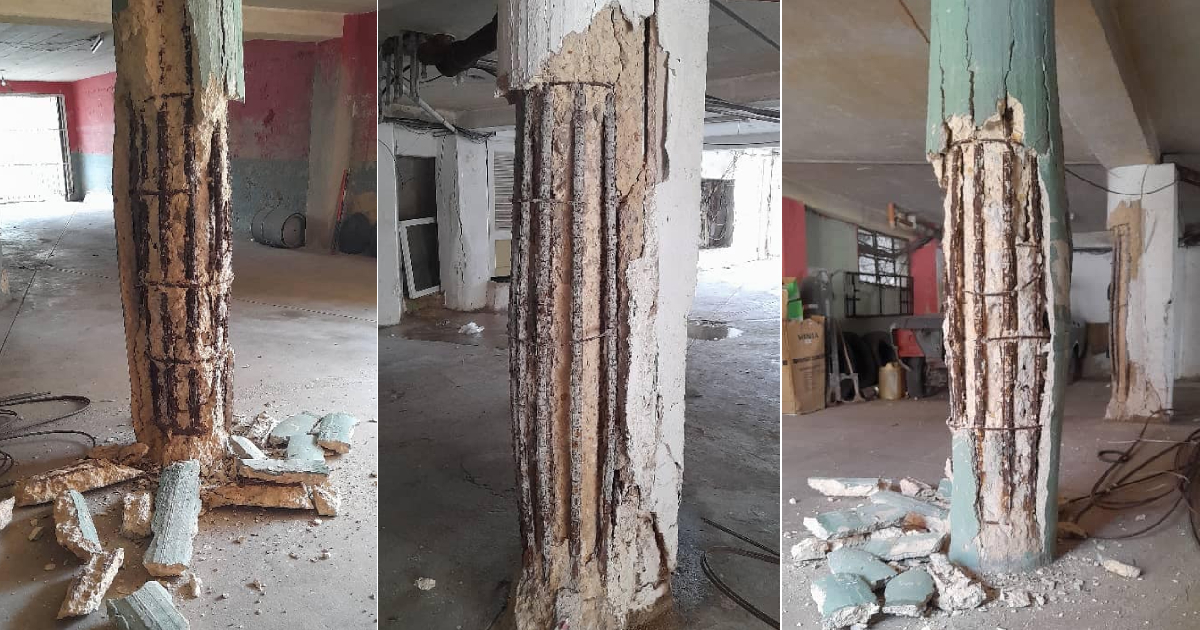
A public complaint on behalf of the residents of a residential building in Havana was made by a Cuban woman who fears the collapse of the construction, due to the apathy and apathy of the authorities responsible for solving the problem.
The Facebook userMarybel García Garzón In a cry of despair on the social network, he said that no one paid attention to his problem, despite understanding “that there are many people who are in the same situation.”
Born and raised in that place, located on Calzada and C, in the popular neighborhood of El Vedado, García Garzón laments the “horrendous panorama,” which she considers not typical of her area but is also national because “our city is collapsing.” , where they build hotels, but we cannot get tired, nor remain silent.”
In the particular case of this building, the affected person says that since 2019, “after many years of fighting”, the municipal Housing Directorate of Plaza de la Revolución approved a budget for the capital repair of the property, however, four years afterThey do not even have the materials or qualified technicians for such a restoration..
He assures that in this situation, by mutual agreement of the residents in the place “we are gathering among all the neighbors the million that is needed for a restoration of this nature,” becauseThey assumed that “they have to solve their problems”.
He adds that a situation that is causing rapid damage to the structure of the building is the presence on the ground floor of the so-called Images Club. An institution that was previously respectful of the community until its administration was assumed by the Palmares Extrahotel Company.
García Garzón denounces that said Cuban state company carried out a terrible remodeling, because "they removed the soundproofing that was already done." In addition to playing the “extremely loud music including matinee (from 3:00 p.m. to 3:00 a.m.).”
He points out that as a consequence the vibrations “are collapsing parts of the columns daily due to the great deterioration” and the noise reaches from the parking lot to the attic.
Despite having gone to the corresponding authorities, and the complainant lists each of them in her post, as well as how they agreed in each case, she points out that they continue to wait and that they refuse to live in those conditions.
“We refuse to die this way (to continue the administration of the Images Club doing whatever it wants), there will not be time to restore the building because it will fall sooner,” he emphasized.
In the comments section this complaint was described as horrible, alarming and dangerous.
“Those columns in that state, with the proximity of the sea, is almost a crime.Contempt and apathy at its finest”said one Internet user.
Another person added that “the situation is degrading,” and concluded with a statement that denotes the reality of many collapsing buildings in Cuba when he said: “It seems that the solution is tragedy, wait for it to collapse and a few die and then mourn our dead”.
Meanwhile, a user reflected that“This is mine, yours, the other's, all of Cuba, especially Havana”.
In December of last yearThe intense rains associated with the entry of a cold front in the Cuban capital caused the partial collapse of a building located in Central Havana.
The property, located on the corner of San Lázaro and Perseverancia streets, had already been the subject of a complaint from a neighbor who protested against its poor state of conservation and structural problems.
At the end of January of this year,The façade of a dilapidated building located near the Saratoga Hotel collapsed.
The property was located on the corner of Dragones and Monserrate streets, right in front of the emblematic Martí Theater.
“That facade collapsed and I doubt it can be saved. Many people have not even found out yet, because for the few passers-by who walk through that disaster zone, landslides are an everyday occurrence and others are no longer interested," the documentary filmmaker of Salvadoran origin explained on social networks.Jorge Dalton, where he shared several photos showing what the area looked like, which was with scaffolding and where access was prohibited.
What do you think?
COMMENTFiled in: